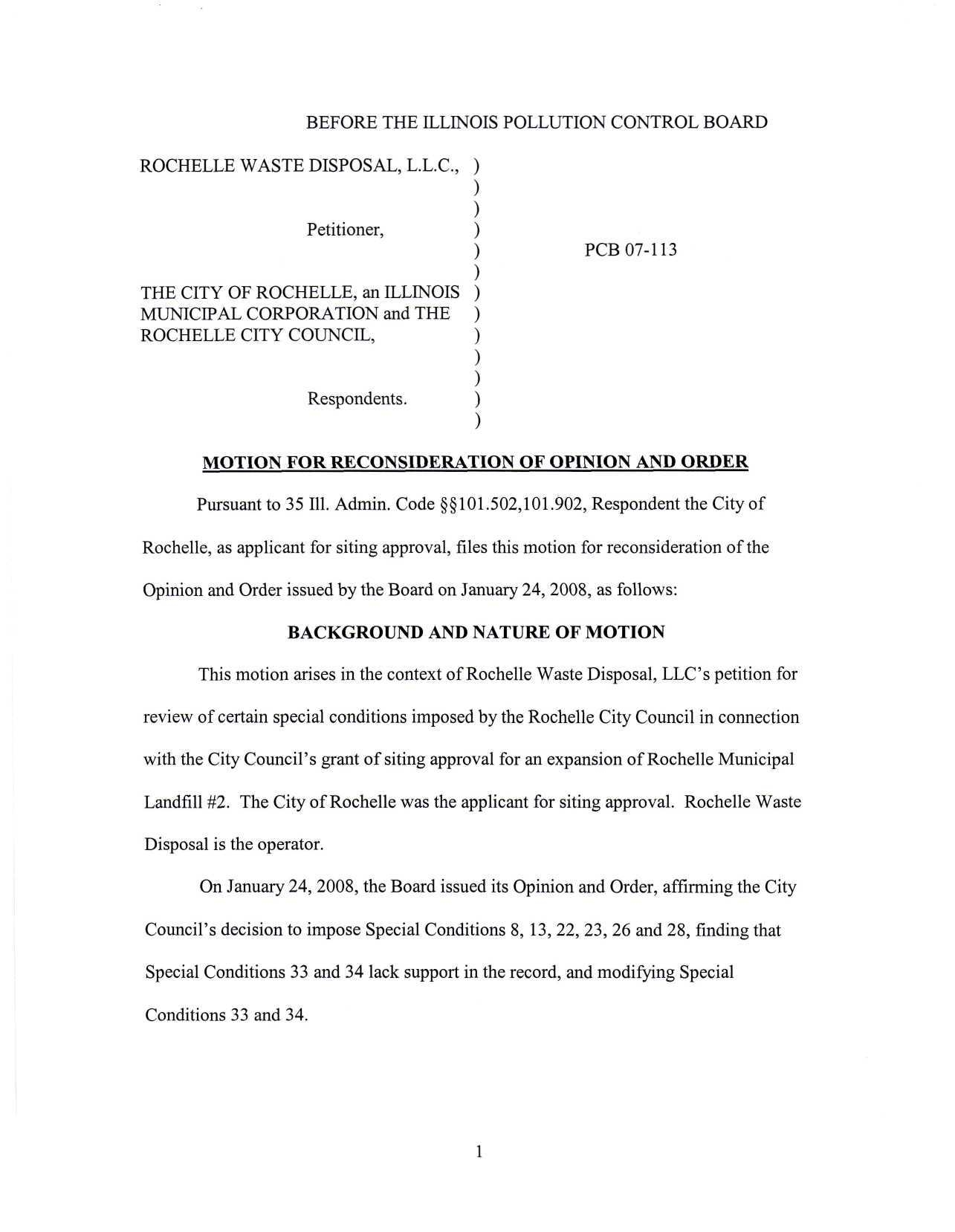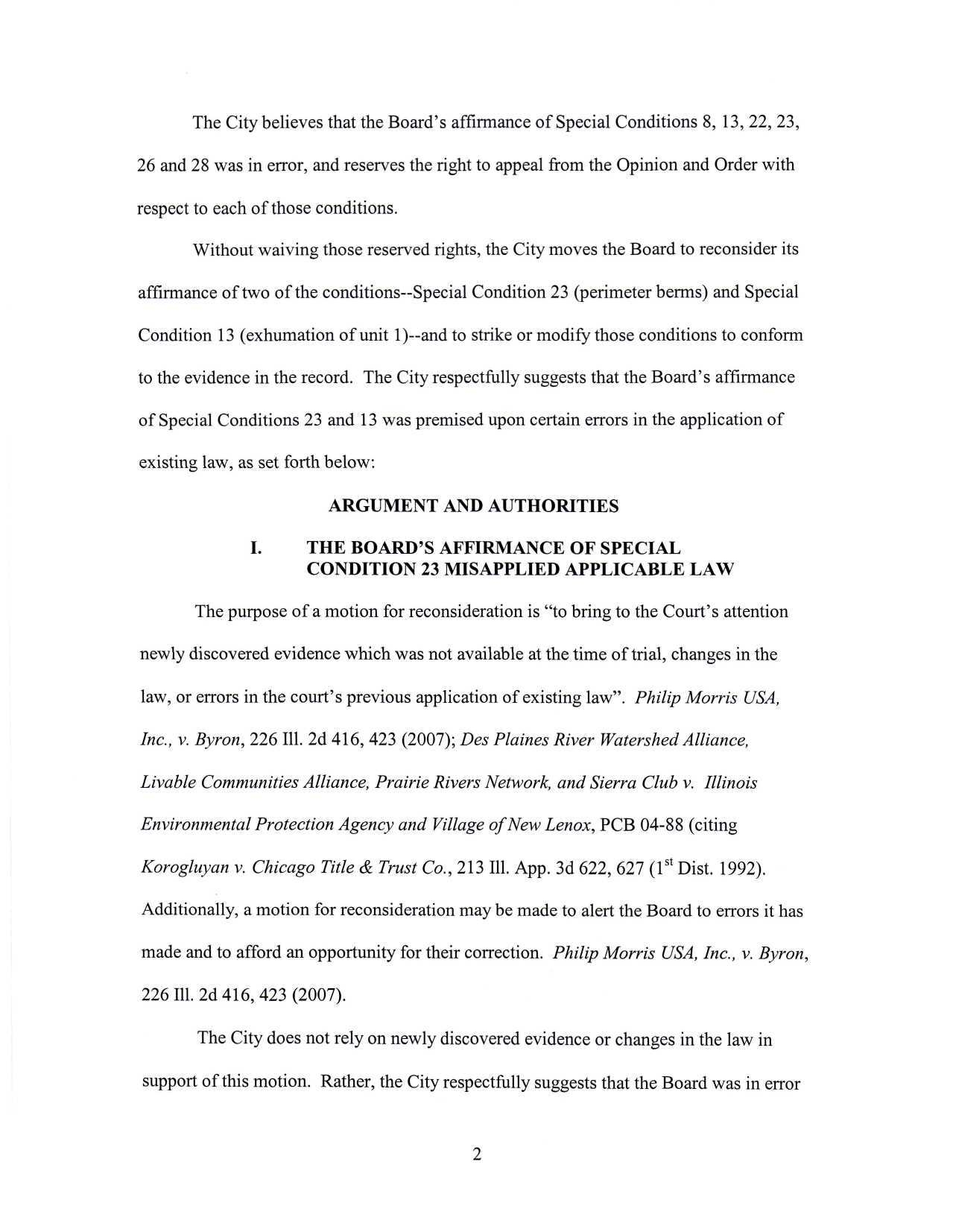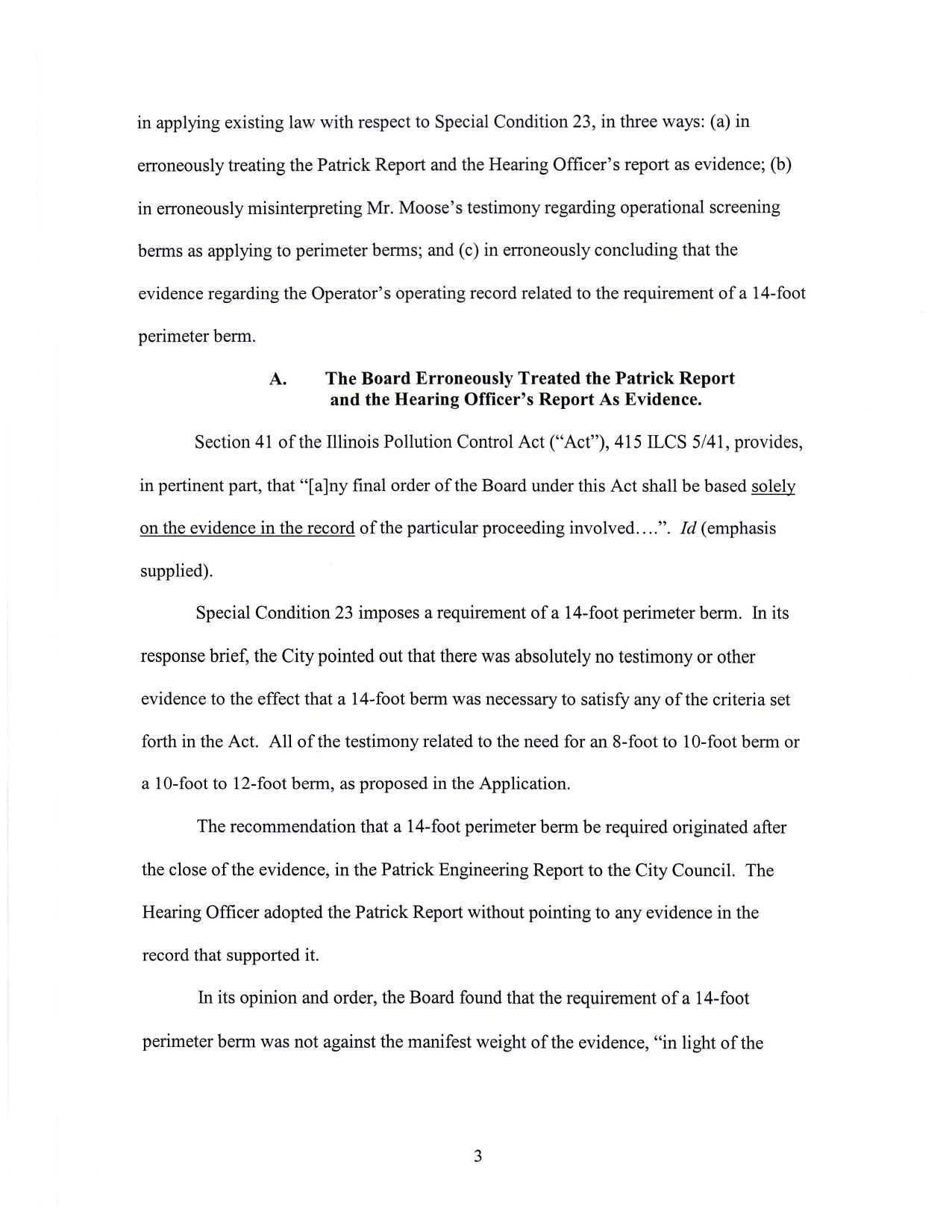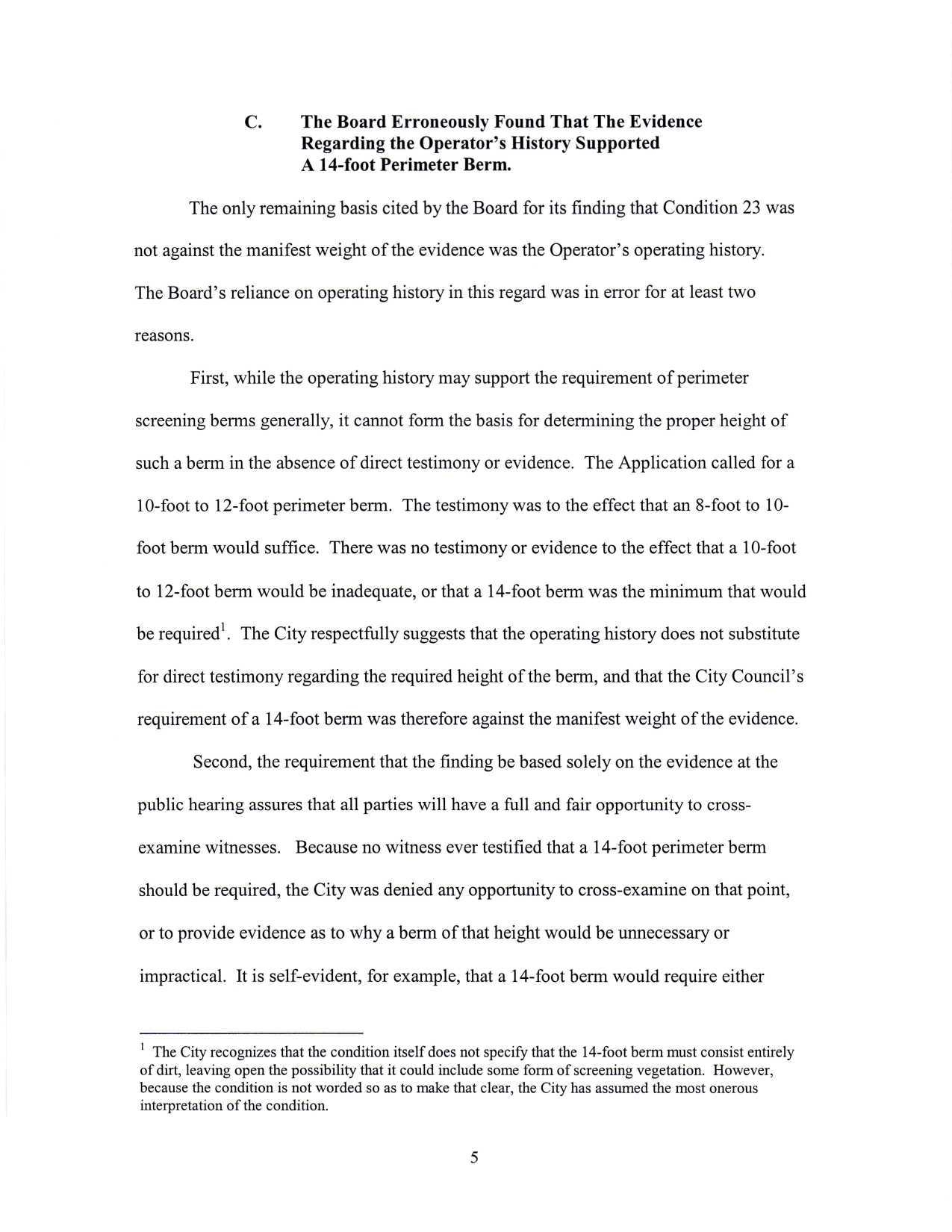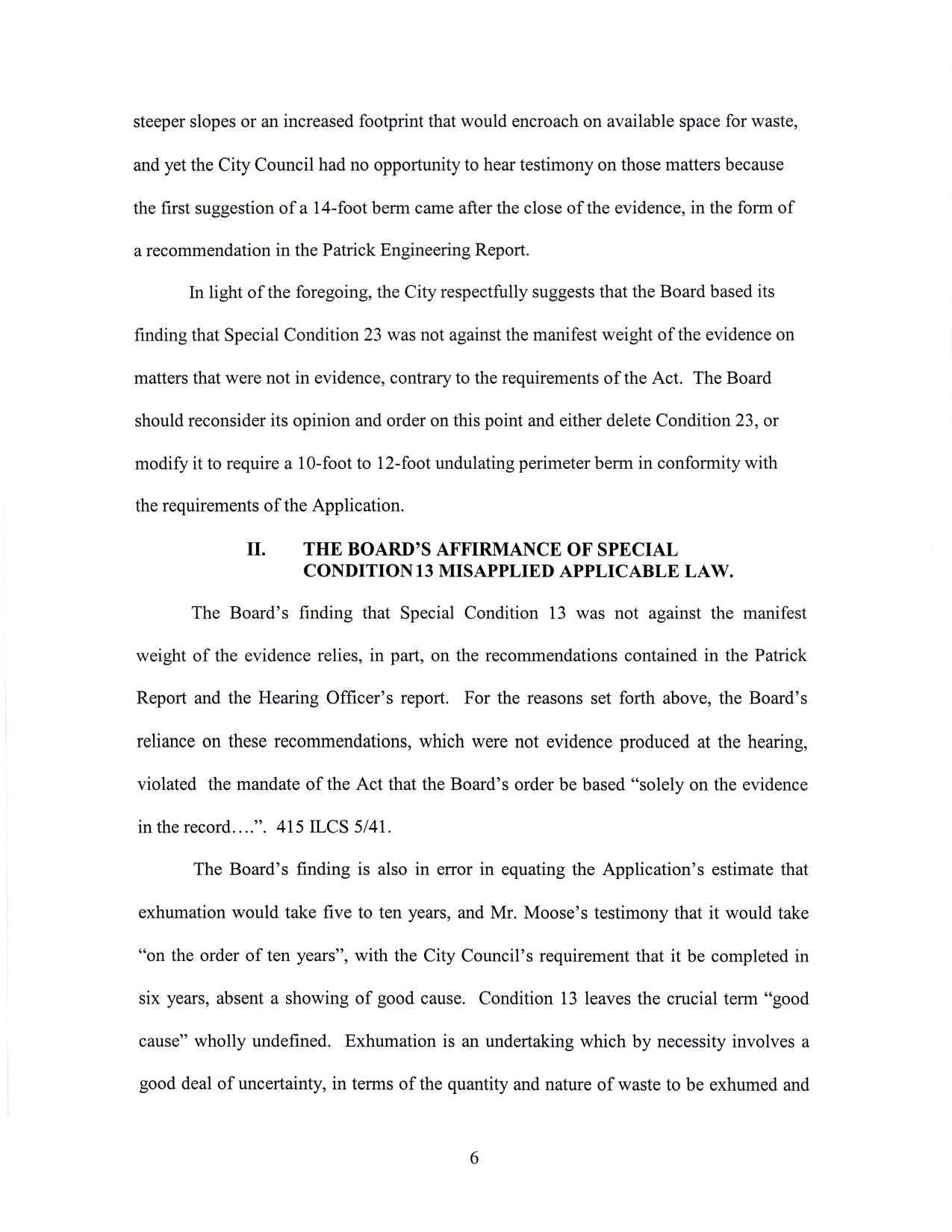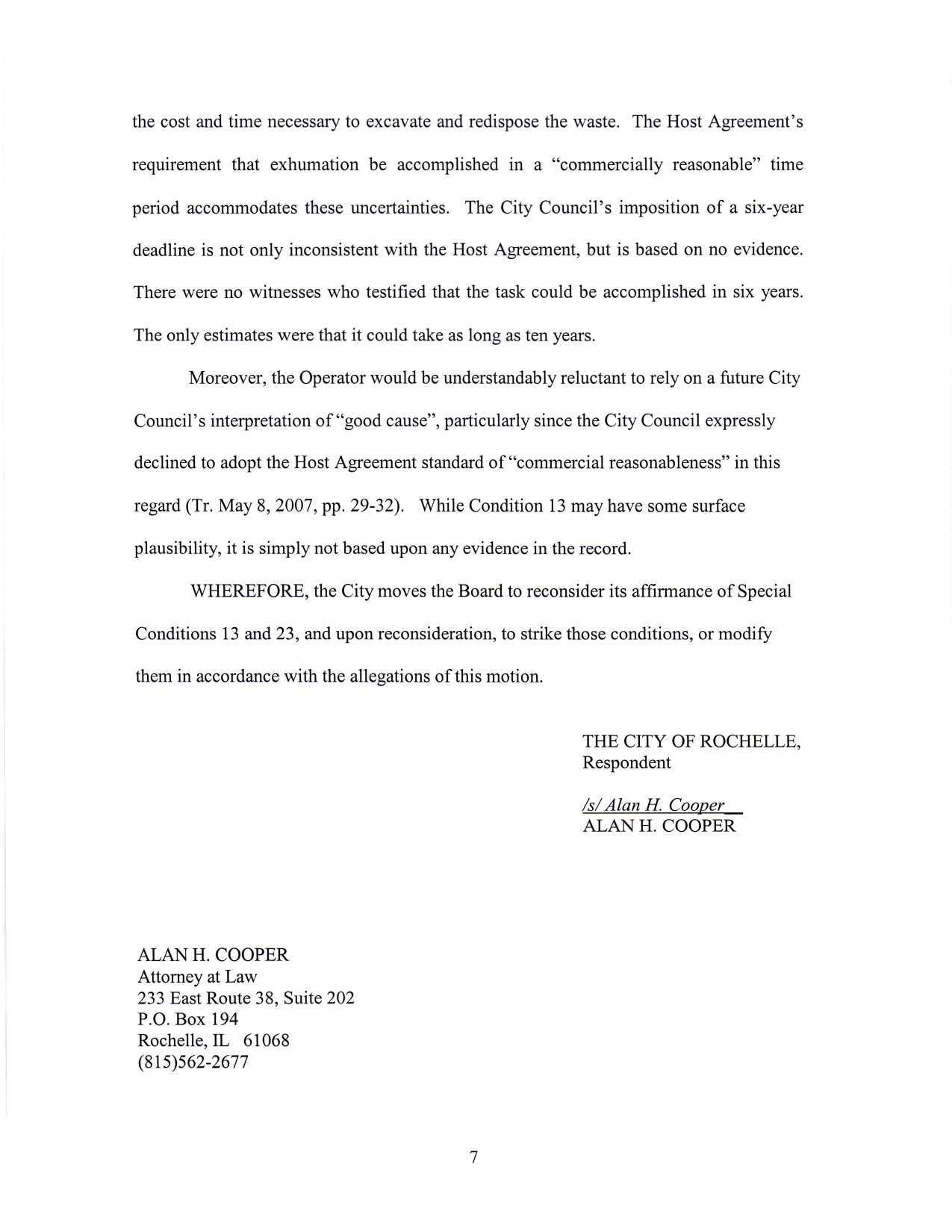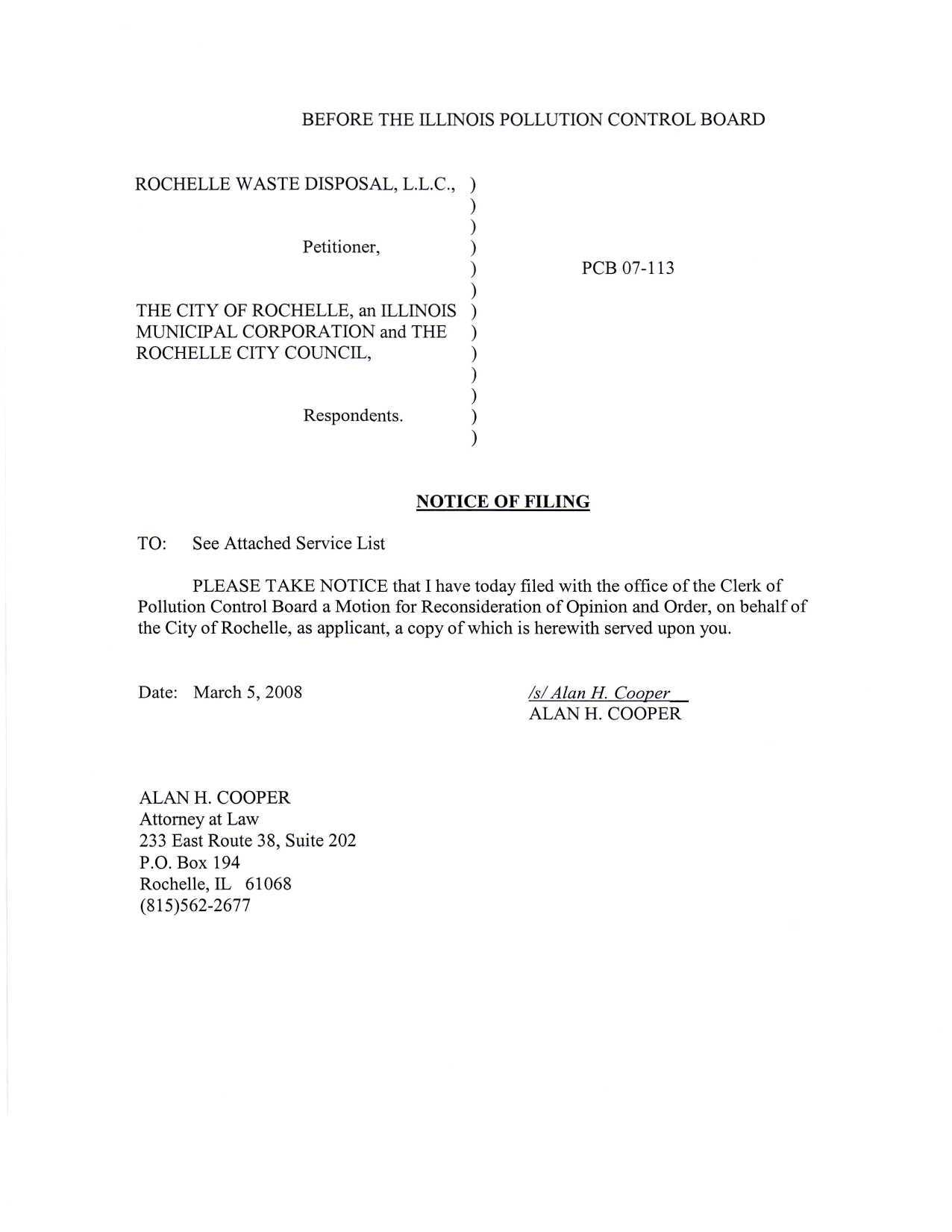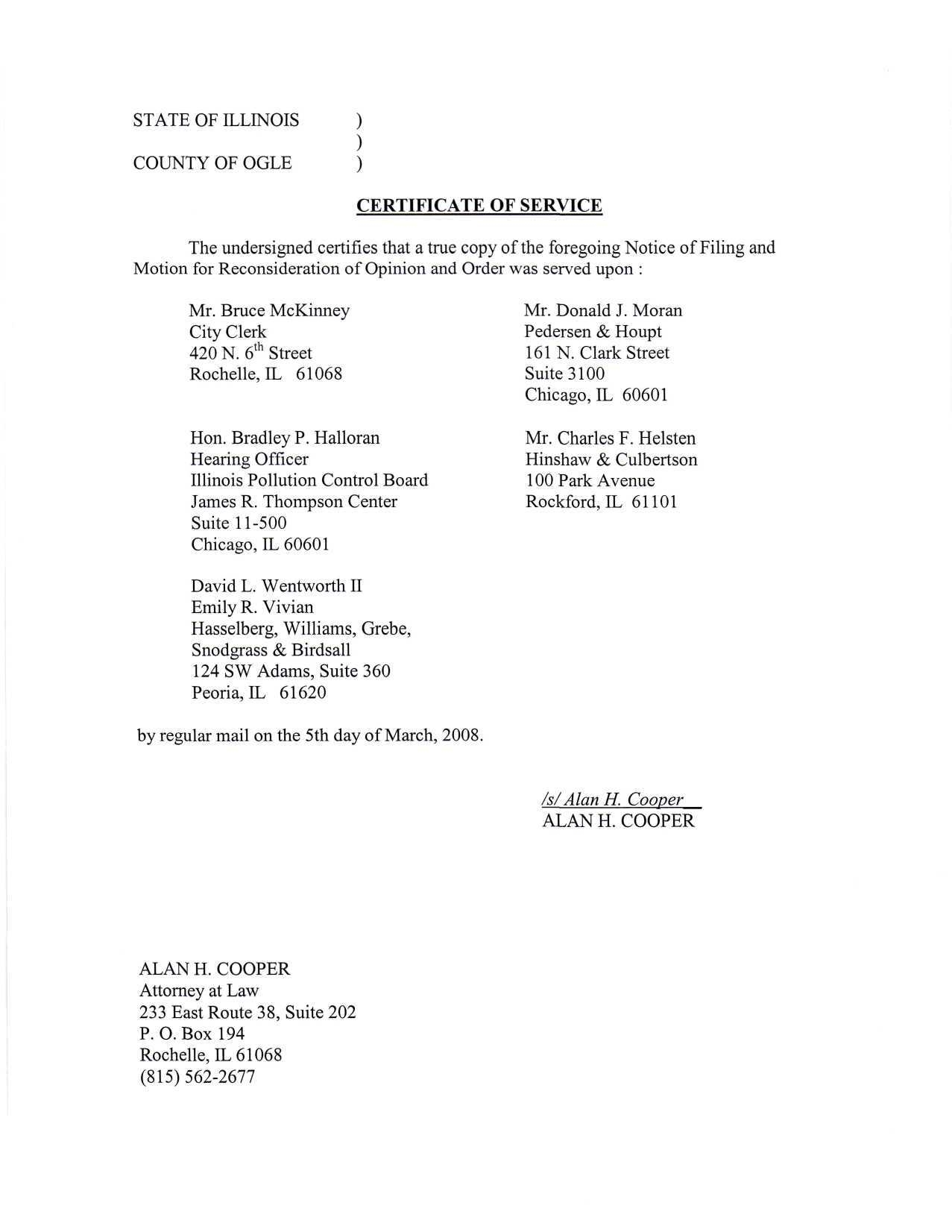BEFORE THE ILLINOIS POLLUTION CONTROL BOARD
ROCHELLE WASTE DISPOSAL, L.L.C., )
Petitioner,
)
)
PCB07-113
)
THE CITY OF ROCHELLE, an ILLINOIS )
MUNICIPAL CORPORATION and THE
)
ROCHELLE CITY COUNCIL,
)
Respondents.
)
)
MOTION FOR RECONSIDERATION OF OPINION AND ORDER
Pursuant to 35 111. Admin. Code §§101.502,101.902, Respondent the City of
Rochelle, as applicant for siting approval, files this motion for reconsideration of the
Opinion and Order issued by the Board on January 24, 2008, as follows:
BACKGROUND AND NATURE OF MOTION
This motion arises in the context of Rochelle Waste Disposal, LLC's petition for
review of certain special conditions imposed by the Rochelle City Council in connection
with the City Council's grant of siting approval for an expansion of Rochelle Municipal
Landfill
#2.
The City of Rochelle was the applicant for siting approval. Rochelle Waste
Disposal is the operator.
On January 24, 2008, the Board issued its Opinion and Order, affirming the City
Council's decision to impose Special Conditions 8, 13, 22, 23, 26 and 28, finding that
Special Conditions 33 and 34 lack support in the record, and modifying Special
Conditions 33 and 34.
Electronic Filing - Received, Clerk's Office, March 5, 2008
The City believes that the Board's affirmance of Special Conditions 8, 13, 22, 23,
26 and 28 was in error, and reserves the right to appeal from the Opinion and Order with
respect to each of those conditions.
Without waiving those reserved rights, the City moves the Board to reconsider its
affirmance of two of the conditions—Special Condition 23 (perimeter berms) and Special
Condition 13 (exhumation of unit 1)—and to strike or modify those conditions to conform
to the evidence in the record. The City respectfully suggests that the Board's affirmance
of Special Conditions 23 and 13 was premised upon certain errors in the application of
existing law, as set forth below:
ARGUMENT AND AUTHORITIES
I.
THE BOARD'S AFFIRMANCE OF SPECIAL
CONDITION
23
MISAPPLIED APPLICABLE LAW
The purpose of a motion for reconsideration is "to bring to the Court's attention
newly discovered evidence which was not available at the time of trial, changes in the
law, or errors in the court's previous application of existing law".
Philip Morris USA,
Inc., v. Byron,
226 111. 2d 416, 423 (2007);
Des Plaines River Watershed Alliance,
Livable Communities Alliance, Prairie Rivers Network, and Sierra Club v. Illinois
Environmental Protection Agency and Village of New Lenox,
PCB 04-88 (citing
Korogluyan v. Chicago Title & Trust Co.,
213 111. App. 3d 622, 627 (1st Dist. 1992).
Additionally, a motion for reconsideration may be made to alert the Board to errors it has
made and to afford an opportunity for their correction.
Philip Morris USA, Inc., v. Byron,
226 111. 2d 416,423 (2007).
The City does not rely on newly discovered evidence or changes in the law in
support of this motion. Rather, the City respectfully suggests that the Board was in error
Electronic Filing - Received, Clerk's Office, March 5, 2008
in applying existing law with respect to Special Condition 23, in three ways: (a) in
erroneously treating the Patrick Report and the Hearing Officer's report as evidence; (b)
in erroneously misinterpreting Mr. Moose's testimony regarding operational screening
berms as applying to perimeter berms; and (c) in erroneously concluding that the
evidence regarding the Operator's operating record related to the requirement of a 14-foot
perimeter berm.
A.
The Board Erroneously Treated the Patrick Report
and the Hearing Officer's Report As Evidence.
Section 41 of the Illinois Pollution Control Act ("Act"), 415 ILCS 5/41, provides,
in pertinent part, that "[a]ny final order of the Board under this Act shall be based solely
on the evidence in the record of the particular proceeding involved....".
Id
(emphasis
supplied).
Special Condition 23 imposes a requirement of a 14-foot perimeter berm. In its
response brief, the City pointed out that there was absolutely no testimony or other
evidence to the effect that a 14-foot berm was necessary to satisfy any of the criteria set
forth in the Act. All of the testimony related to the need for an 8-foot to 10-foot berm or
a 10-foot to 12-foot berm, as proposed in the Application.
The recommendation that a 14-foot perimeter berm be required originated after
the close of the evidence, in the Patrick Engineering Report to the City Council. The
Hearing Officer adopted the Patrick Report without pointing to any evidence in the
record that supported it.
In its opinion and order, the Board found that the requirement of a 14-foot
perimeter berm was not against the manifest weight of the evidence, "in light of the
Electronic Filing - Received, Clerk's Office, March 5, 2008
recommendations from Patrick Engineering and the hearing officer, the testimony of Mr.
Moose, and RWD's operating record." (Opinion, page 52).
In relying on the Patrick Report and the Hearing Officer's recommendations as
supporting a finding that Special Condition 23 was not against the manifest weight of the
evidence, the Board based its decision on matters which were not "the evidence in the
record", as required by the Act, and thereby misapplied existing law. The Act makes
clear that the Board is to base its order on the evidence in the record made at the hearing.
The hearing was closed before the Patrick Report was filed and, in any event, the Patrick
Report is not itself evidence. Likewise, the Hearing Officer's report and recommendation
is not evidence and was made after the close of the hearing. The fact that Patrick
Engineering made a recommendation for a 14-foot perimeter berm, and the fact that the
Hearing Officer adopted that recommendation, do not serve as substitutes for the required
evidence. The Board's opinion and order erroneously treated those recommendations as
evidence, contrary to the mandate of the Act.
B.
The Board Erroneously Treated Mr. Moose's
Testimony as Relating to Perimeter Berms
The Board also referred to "the testimony of Mr. Moose", in support of its finding
that Special Condition 23 was not against the manifest weight of the evidence. However,
the only testimony of Mr. Moose cited by the Board related to operational screening
berms, which are the subject of Special Condition 22. Neither Mr. Moose, nor any other
witness, testified in favor of al4-foot perimeter berm. The Board's reliance on Mr.
Moose's testimony regarding operational screening berms as somehow supporting the
Patrick Report's recommendation of 14-foot screening berms erroneously characterized
that testimony and was in error.
Electronic Filing - Received, Clerk's Office, March 5, 2008
C.
The Board Erroneously Found That The Evidence
Regarding the Operator's History Supported
A 14-foot Perimeter Berm.
The only remaining basis cited by the Board for its finding that Condition 23 was
not against the manifest weight of the evidence was the Operator's operating history.
The Board's reliance on operating history in this regard was in error for at least two
reasons.
First, while the operating history may support the requirement of perimeter
screening berms generally, it cannot form the basis for determining the proper height of
such a berm in the absence of direct testimony or evidence. The Application called for a
10-foot to 12-foot perimeter berm. The testimony was to the effect that an 8-foot to 10-
foot berm would suffice. There was no testimony or evidence to the effect that a 10-foot
to 12-foot berm would be inadequate, or that a 14-foot berm was the minimum that would
be required1. The City respectfully suggests that the operating history does not substitute
for direct testimony regarding the required height of the berm, and that the City Council's
requirement of a 14-foot berm was therefore against the manifest weight of the evidence.
Second, the requirement that the finding be based solely on the evidence at the
public hearing assures that all parties will have a full and fair opportunity to cross-
examine witnesses. Because no witness ever testified that a 14-foot perimeter berm
should be required, the City was denied any opportunity to cross-examine on that point,
or to provide evidence as to why a berm of that height would be unnecessary or
impractical. It is self-evident, for example, that a 14-foot berm would require either
1 The City recognizes that the condition itself does not specify that the 14-foot berm must consist entirely
of dirt, leaving open the possibility that it could include some form of screening vegetation. However,
because the condition is not worded so as to make that clear, the City has assumed the most onerous
interpretation of the condition.
Electronic Filing - Received, Clerk's Office, March 5, 2008
steeper slopes or an increased footprint that would encroach on available space for waste,
and yet the City Council had no opportunity to hear testimony on those matters because
the first suggestion of a 14-foot berm came after the close of the evidence, in the form of
a recommendation in the Patrick Engineering Report.
In light of the foregoing, the City respectfully suggests that the Board based its
finding that Special Condition 23 was not against the manifest weight of the evidence on
matters that were not in evidence, contrary to the requirements of the Act. The Board
should reconsider its opinion and order on this point and either delete Condition 23, or
modify it to require a 10-foot to 12-foot undulating perimeter berm in conformity with
the requirements of the Application.
II.
THE BOARD'S AFFIRMANCE OF SPECIAL
CONDITION 13 MISAPPLIED APPLICABLE LAW.
The Board's finding that Special Condition 13 was not against the manifest
weight of the evidence relies, in part, on the recommendations contained in the Patrick
Report and the Hearing Officer's report. For the reasons set forth above, the Board's
reliance on these recommendations, which were not evidence produced at the hearing,
violated the mandate of the Act that the Board's order be based "solely on the evidence
in the record....". 415 ILCS 5/41.
The Board's finding is also in error in equating the Application's estimate that
exhumation would take five to ten years, and Mr. Moose's testimony that it would take
"on the order often years", with the City Council's requirement that it be completed in
six years, absent a showing of good cause. Condition 13 leaves the crucial term "good
cause" wholly undefined. Exhumation is an undertaking which by necessity involves a
good deal of uncertainty, in terms of the quantity and nature of waste to be exhumed and
Electronic Filing - Received, Clerk's Office, March 5, 2008
the cost and time necessary to excavate and redispose the waste. The Host Agreement's
requirement that exhumation be accomplished in a "commercially reasonable" time
period accommodates these uncertainties. The City Council's imposition of a six-year
deadline is not only inconsistent with the Host Agreement, but is based on no evidence.
There were no witnesses who testified that the task could be accomplished in six years.
The only estimates were that it could take as long as ten years.
Moreover, the Operator would be understandably reluctant to rely on a future City
Council's interpretation of "good cause", particularly since the City Council expressly
declined to adopt the Host Agreement standard of "commercial reasonableness" in this
regard (Tr. May 8, 2007, pp. 29-32). While Condition 13 may have some surface
plausibility, it is simply not based upon any evidence in the record.
WHEREFORE, the City moves the Board to reconsider its affirmance of Special
Conditions 13 and 23, and upon reconsideration, to strike those conditions, or modify
them in accordance with the allegations of this motion.
THE CITY OF ROCHELLE,
Respondent
Is/Alan H. Cooper
ALAN H. COOPER
ALAN H. COOPER
Attorney at Law
233 East Route 38, Suite 202
P.O. Box 194
Rochelle, IL 61068
(815)562-2677
Electronic Filing - Received, Clerk's Office, March 5, 2008
BEFORE THE ILLINOIS POLLUTION CONTROL BOARD
ROCHELLE WASTE DISPOSAL, L.L.C., )
Petitioner,
)
)
PCB07-113
THE CITY OF ROCHELLE, an ILLINOIS )
MUNICIPAL CORPORATION and THE
)
ROCHELLE CITY COUNCIL,
)
Respondents.
)
NOTICE OF FILING
TO:
See Attached Service List
PLEASE TAKE NOTICE that I have today filed with the office of the Clerk of
Pollution Control Board a Motion for Reconsideration of Opinion and Order, on behalf of
the City of Rochelle, as applicant, a copy of which is herewith served upon you.
Date: March 5, 2008
/s/Alan H. Cooyer
ALAN H. COOPER
ALAN H. COOPER
Attorney at Law
233 East Route 38, Suite 202
P.O. Box 194
Rochelle, IL 61068
(815)562-2677
Electronic Filing - Received, Clerk's Office, March 5, 2008
STATE OF ILLINOIS
COUNTY OF OGLE
CERTIFICATE OF SERVICE
The undersigned certifies that a true copy of the foregoing Notice of Filing and
Motion for Reconsideration of Opinion and Order was served upon :
Mr. Bruce McKinney
City Clerk
420 N. 6th Street
Rochelle, IL 61068
Hon. Bradley P. Halloran
Hearing Officer
Illinois Pollution Control Board
James R. Thompson Center
Suite 11-500
Chicago, IL 60601
David L. Wentworth II
Emily R. Vivian
Hasselberg, Williams, Grebe,
Snodgrass & Birdsall
124 SW Adams, Suite 360
Peoria, IL 61620
by regular mail on the 5th day of March, 2008.
Mr. Donald J. Moran
Pedersen & Houpt
161 N.Clark Street
Suite 3100
Chicago, IL 60601
Mr. Charles F. Helsten
Hinshaw & Culbertson
100 Park Avenue
Rockford, IL 61101
Is/ Alan H. Cooper
ALAN H. COOPER
ALAN H. COOPER
Attorney at Law
233 East Route 38, Suite 202
P. O. Box 194
Rochelle, IL 61068
(815)562-2677
Electronic Filing - Received, Clerk's Office, March 5, 2008
